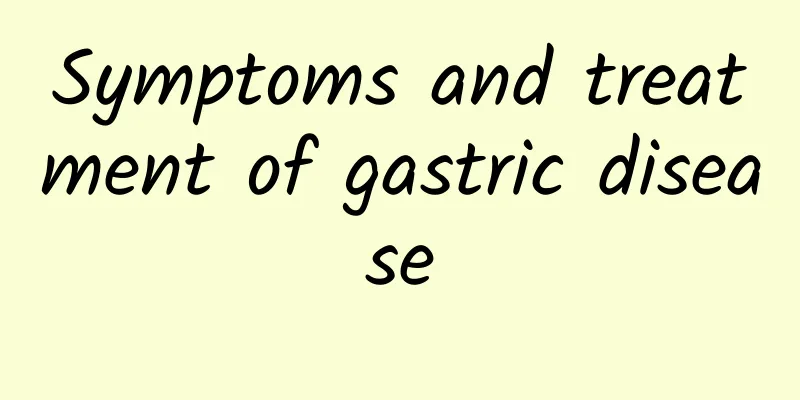Symptoms and treatment of gastric disease

|
With the improvement of living standards and the increase of life pressure, more and more people suffer from various stomach problems, including gastritis, gastric ulcer, etc. The symptoms of each stomach disease are different, and the treatment methods are also different. Stomach disease also troubles many young people. Stomach pain is not a disease, but it can be fatal. Therefore, we must try our best to treat the pain of stomach disease. Since there are so many types of stomach diseases, we don’t know every type of stomach disease. What are the symptoms and treatments of each stomach disease? Today, let’s summarize and understand the symptoms and treatments of various stomach diseases to improve our stomach diseases. The most common symptoms are upper abdominal discomfort or pain, nausea, vomiting, diarrhea, and loss of appetite. Symptoms of gastritis and duodenal ulcers include burning pain in the upper abdomen, especially between meals, before breakfast, or after drinking orange juice or coffee. In severe cases, there may be tarry, black or bloody stools. 1. Acute simple gastritis It is mainly caused by chemical substances, such as strong tea, coffee, liquor, condiments and other irritants, or taking salicylates, sulfonamides, anticancer drugs, antibiotics, reserpine, corticosteroids and other drugs that damage the gastric mucosa; physical factors such as eating too cold, too hot or rough food that damages the gastric mucosa; and microbial infection or bacterial toxins. Acute corrosive gastritis is often caused by suicide or accidental ingestion of corrosive agents such as strong acids and alkalis. 2. Acute erosive (hemorrhagic) gastritis It often occurs in stressful conditions caused by surgery, burns, shock, trauma, multiple organ failure, etc., as well as drinking or taking non-steroidal drugs, and accounts for about 20% of upper gastrointestinal bleeding. 3. Acute suppurative gastritis It is mainly a suppurative disease caused by bacteria such as streptococci, staphylococci and Escherichia coli infecting the stomach wall, also known as cellulitis gastritis. Acute gastritis is a reversible disease and can return to normal through treatment. Through proper treatment, many patients with acute gastritis can recover effectively and completely, and the disease is characterized by coming and going quickly. However, if the treatment is not timely or thorough and the diet is improper, the condition will turn into chronic gastritis if it persists for a long time. 4. Chronic gastritis Chronic gastritis refers to chronic inflammatory changes in the gastric mucosa due to various reasons. It is one of the most common and frequently occurring diseases. The characteristics are that the incidence rate in men is higher than that in women, and the incidence rate tends to increase with age. The essence of chronic gastritis is that after the gastric mucosal epithelium is repeatedly damaged, the mucosa is remodeled due to its specific regenerative ability, and eventually leads to irreversible atrophy or even disappearance of the intrinsic gastric glands. (1) The cause of chronic gastritis is now generally believed to be chronic persistent infection with pathogenic bacteria, especially Hp (Helicobacter pylori); or it may be transformed from acute gastritis. Like acute gastritis, physical factors such as overheating, overcooling, and overly rough food are also one of its causes. In addition, chemical factors, such as strong tea, coffee, strong liquor, condiments, etc.; long-term and large-scale use of non-steroidal drugs (such as aspirin, indomethacin, etc.) can inhibit the synthesis of prostaglandins in the gastric mucosa and damage the mucosal barrier. When smoking, nicotine in tobacco not only affects the blood circulation of the gastric mucosa, but also causes pyloric sphincter dysfunction, resulting in bile reflux. Various bile refluxes can damage the mucosal barrier and lead to the occurrence of chronic gastritis. In addition, immune factors are also the cause of chronic gastritis. (2) Chronic gastritis can be divided into two main types: chronic superficial gastritis and chronic atrophic gastritis, and the two can sometimes coexist. Chronic superficial gastritis includes three types: simple type, erosive type and hemorrhagic type. According to the common site of disease, it can be divided into two categories: Type A is rare, with lesions occurring in the stomach body and fundus, and is mostly caused by autoimmune reactions. Type B is more common, with lesions mainly in the gastric antrum. About 90% of patients are infected with Hp. Type B is the more common type in my country. 5. Non-ulcer dyspepsia Non-ulcer dyspepsia is a functional gastric disease, and a small number of cases are mild organic lesions. In the past, many doctors diagnosed the disease as chronic gastritis, gastric neurosis, gastrointestinal autonomic nervous system dysfunction, functional gastric dyspepsia, gastric spasm, etc. According to the latest authoritative epidemiological survey, the incidence of this disease in the population is as high as 10%, and it is also a common and frequently occurring disease of the stomach. Patients may experience intermittent or persistent upper abdominal pain or occasional severe pain and discomfort, nausea, vomiting, acid reflux, heartburn and other upper gastrointestinal symptoms. However, clinical examinations such as gastroscopy, upper gastrointestinal barium angiography and hepatobiliary and pancreatic ultrasound cannot reveal organic lesions or mild lesions in the stomach and other organs that cause these symptoms. That is to say, there are more subjective symptoms of the stomach, but few or no positive findings in objective tests. The cause of the disease should be related to gastric motility dysfunction, mild gastroduodenal inflammation, and mental factors. 1. Notes First, regularize your diet. Secondly, pay attention to food hygiene. Again, take less medications that are irritating to the stomach. Fourth, stay in a good mood. 2. Medication (1) Eliminate the cause of the disease, rest in bed, and stop all foods and medications that may irritate the stomach. If appropriate, short-term fasting should be implemented, and then an easily digestible, light, low-residue liquid diet should be given to help the stomach rest and the injury heal. (2) Encourage drinking water. Since patients lose too much water due to vomiting and diarrhea, they should drink as much water as possible to replenish the lost water. It is better to use sugar and salt water (made by adding a small amount of sugar and salt to boiled water). Do not drink beverages high in sugar to avoid excessive acid production and aggravate abdominal pain. Patients with frequent vomiting can drink a small amount of water (about 50 ml) after each vomiting, and drink it multiple times to avoid vomiting. (3) Pain relief. Belladonna tablets, atropine, 654-2 and other drugs can be used. You can also apply local hot compress to the abdomen to relieve pain (not necessary for those with gastric bleeding). (4) For patients with diarrhea and fever, antibacterial drugs such as berberine and norfloxacin can be used appropriately. It is generally not used by patients with mild conditions to avoid further irritation to the stomach. (5) Patients with severe vomiting, diarrhea, and obvious dehydration should be sent to the hospital for intravenous infusion treatment in a timely manner. They will generally recover within 1-2 days. (6) Prevention is the priority. Drink in moderation, avoid overeating, and use with caution or not use drugs that can easily damage the gastric mucosa. Acute simple gastritis must be treated promptly and recurrence must be prevented after recovery to prevent it from turning into chronic gastritis and becoming unrecoverable. The above is a summary of the symptoms and treatment plans of several stomach diseases. These are not all the symptoms and treatments of stomach diseases. However, they are the most common stomach diseases and treatments. With the above summary, we will no longer be afraid of stomach diseases invading us. We can prevent and treat them. |
<<: Symptoms of blocked meridians in the legs
>>: Symptoms of Cystitis Glandularis
Recommend
What are the Chinese patent medicines for regulating the spleen and stomach?
Insomnia is a very common clinical condition, and...
Color and volume of menstrual period during menopause
When women reach menopause, they will gradually g...
Representative prescriptions for nourishing blood and softening the liver
Humans need to carry out normal metabolism every ...
What causes cervical spondylosis?
With the development of science and technology an...
What to do if you are allergic to tetanus shots? Complete list of treatments with Chinese and Western medicine
If we accidentally bump into something and break ...
Difficulty falling asleep, regulating the liver; easy waking, regulating the spleen; not being able to fall asleep, regulating the kidneys
It's very torturous to be unable to sleep at ...
How long in advance should Rhodiola be taken?
Generally speaking, Rhodiola needs to be taken 10...
How to quickly reduce swelling after rhinoplasty
The nose is known as the "organ of judgment&...
Can I eat eggs if I have a sore throat?
When it comes to sore throat, many people may be ...
Can I drink water on the morning of the physical examination?
We all know that physical examinations are needed...
Top Ten Chinese Patent Medicines for Kidney Yin and Yang Deficiency
In life, people don't know that kidney defici...
Does drinking liquor lower blood pressure?
Drinking too much alcohol will cause alcohol pois...
What is sulfuric acid paper?
Sulfuric acid paper is also called platemaking su...
What are the dietary precautions for premature placenta?
The placenta can deliver nutrients to the fetus. ...
Western medicine for treating chronic gastritis
Chronic gastritis is a common type of gastritis w...









